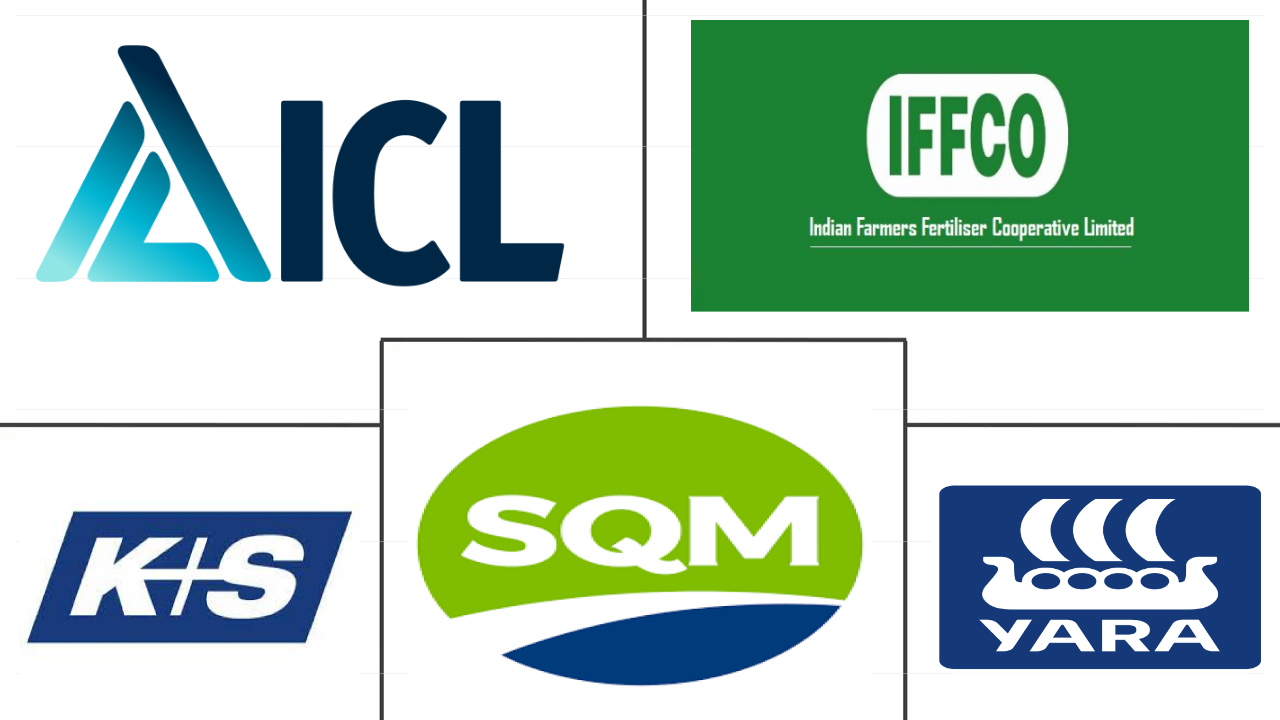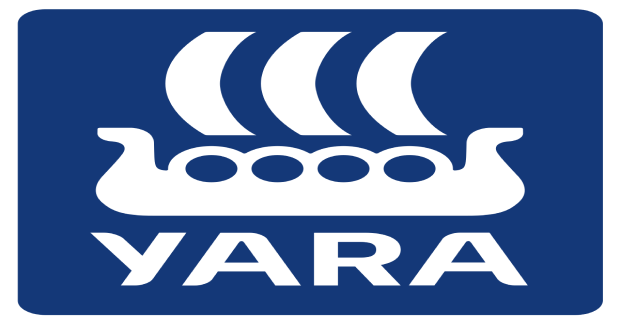Market Size of water soluble fertilizer Industry
|
|
Study Period | 2017 - 2030 |
|
|
Market Size (2024) | USD 19.61 Billion |
|
|
Market Size (2030) | USD 28.2 Billion |
|
|
Largest Share by Crop Type | Field Crops |
|
|
CAGR (2024 - 2030) | 6.24 % |
|
|
Largest Share by Region | Asia-Pacific |
Major Players |
||

|
||
|
*Disclaimer: Major Players sorted in no particular order |
Water Soluble Fertilizer Market Analysis
The Water Soluble Fertilizer Market size is estimated at 19.61 billion USD in 2024, and is expected to reach 28.2 billion USD by 2030, growing at a CAGR of 6.24% during the forecast period (2024-2030).
19.61 Billion
Market Size in 2024 (USD)
28.2 Billion
Market Size in 2030 (USD)
6.75 %
CAGR (2017-2023)
6.24 %
CAGR (2024-2030)
Largest segment by Type
41.68 %
value share, Phosphatic, 2023
Phosphatic fertilizers are commonly used in water-soluble forms due to their solubility in water, providing an accessible source of phosphorus for plants.
Largest segment by Application Mode
54.09 %
value share, Fertigation, 2023
The higher share of the fertigation method is due to the global adoption of micro-irrigation systems. This method is precise in delivering fertilizers directly to the plant's root zone.
Largest Segment by Crop Type
7.40 %
Projected CAGR, Horticultural Crops, 2024-2030
The demand for water-soluble is high in horticultural crops due to their quick nutrient availability and the large horticulture area equipped with irrigation system.
Largest segment by Country
29.49 %
value share, China, 2023
The consumption of water-soluble fertilizers increased in the country due to the advantages such as reduced fertilizer usage, water, labor, and increased yield of the crops.
Leading Market Player
17.45 %
market share, Yara International ASA, 2022

Yara has secured the leading position in the market by offering a wide range of water-soluble fertilizers. YaraBela and YaraRega are the popular brand of the company.
The expansion of cultivation areas is driving the demand for water-soluble fertilizers, improving productivity
- Field crop cultivation dominates globally, accounting for about 78.8% of the total water-soluble fertilizer consumption. The cultivation of these crops led to a consumption of 29.1 million metric tons of water-soluble fertilizers, valued at USD 18.19 billion. The large consumption of water-soluble fertilizers by field crops was due to the large area under the cultivation of these crops. More than 90.0% of the global agricultural land is dedicated to the cultivation of field crops.
- Generally, there is more demand for water-soluble fertilizers in horticultural crops, as they are well-equipped for irrigation like sprinkler or micro irrigation systems. Water-soluble fertilizers can be applied using the foliar or fertigation method. Horticultural crops are the second-largest crop types that consume water-soluble fertilizers, and they accounted for about 18.8% of the global water-soluble fertilizer market volume in 2022. Foliar water-soluble fertilizers play an important role in fruit crops, as foliar spraying is known to improve the quality of the fruits.
- Turf & ornamental crops account for about 3.5% of the global water-soluble fertilizer market volume and consume 984.0 thousand million metric tons. The growing demand for these crops in various applications and the adoption of environmentally friendly fertilizers are increasing the market for water-soluble fertilizers in these crops. The market is expected to register a CAGR of 5.4% due to the increasing area under cultivation of turf & ornamental crops. This is due to the increasing concern over pollution and the growing importance of aesthetic landscaping gardens and ecotourism globally.
- Therefore, the global consumption of water-soluble fertilizers in respective crop types is anticipated to grow during 2023-2030.
The market is witnessing growth as farmers prioritize maximizing crop yields
- The Asia-Pacific water-soluble fertilizer market accounted for 43.9% of market share and witnessed stable growth during the study period, with an overall value in the country amounting to USD 10.1 billion in 2022. Field crops occupied the largest share of 81.6%, followed by horticultural crops.
- Over the past few years, the soluble fertilizer industry in China has experienced significant growth and development due to its numerous benefits. This industry has proven to be an effective solution for reducing fertilizer usage, water, labor, and cost while simultaneously increasing crop yield and quality. This growth has been facilitated by the government's favorable policies toward modern agriculture development and substantial investment in the industry.
- The market for specialty fertilizers in North America is largely dominated by water-soluble fertilizers, which held a market share of 52.8% in 2022. The demand for these fertilizers is influenced by the variety of nutrient grades available, as well as the different application modes such as foliar or fertigation, depending on the specific application requirements. Based on the analysis, the fertigation mode accounted for 54.7% of the market share in 2022, while the foliar application mode accounted for 45.3%.
- In recent years, there has been a considerable surge in the demand for specialized fertilizers, such as water-soluble fertilizers, among farmers worldwide. The primary reason behind this trend is that farmers are increasingly looking to maximize their crop yield per hectare. These fertilizers are known to provide the required nutrients to the crops in a readily available form, promoting better plant growth and yield. As a result, the market is expected to continue to grow during 2023-2030.
Water Soluble Fertilizer Industry Segmentation Water Soluble Fertilizer Industry Segmentation
Complex, Straight are covered as segments by Type. Fertigation, Foliar are covered as segments by Application Mode. Field Crops, Horticultural Crops, Turf & Ornamental are covered as segments by Crop Type. Asia-Pacific, Europe, Middle East & Africa, North America, South America are covered as segments by Region.
- Field crop cultivation dominates globally, accounting for about 78.8% of the total water-soluble fertilizer consumption. The cultivation of these crops led to a consumption of 29.1 million metric tons of water-soluble fertilizers, valued at USD 18.19 billion. The large consumption of water-soluble fertilizers by field crops was due to the large area under the cultivation of these crops. More than 90.0% of the global agricultural land is dedicated to the cultivation of field crops.
- Generally, there is more demand for water-soluble fertilizers in horticultural crops, as they are well-equipped for irrigation like sprinkler or micro irrigation systems. Water-soluble fertilizers can be applied using the foliar or fertigation method. Horticultural crops are the second-largest crop types that consume water-soluble fertilizers, and they accounted for about 18.8% of the global water-soluble fertilizer market volume in 2022. Foliar water-soluble fertilizers play an important role in fruit crops, as foliar spraying is known to improve the quality of the fruits.
- Turf & ornamental crops account for about 3.5% of the global water-soluble fertilizer market volume and consume 984.0 thousand million metric tons. The growing demand for these crops in various applications and the adoption of environmentally friendly fertilizers are increasing the market for water-soluble fertilizers in these crops. The market is expected to register a CAGR of 5.4% due to the increasing area under cultivation of turf & ornamental crops. This is due to the increasing concern over pollution and the growing importance of aesthetic landscaping gardens and ecotourism globally.
- Therefore, the global consumption of water-soluble fertilizers in respective crop types is anticipated to grow during 2023-2030.
| Type | |||||||||
| Complex | |||||||||
|
| Application Mode | |
| Fertigation | |
| Foliar |
| Crop Type | |
| Field Crops | |
| Horticultural Crops | |
| Turf & Ornamental |
| Region | |||||||||||||
| |||||||||||||
| |||||||||||||
| |||||||||||||
| |||||||||||||
|
Water Soluble Fertilizer Market Size Summary
The water-soluble fertilizer market is experiencing significant growth, driven by the increasing demand for efficient agricultural practices worldwide. This market is primarily dominated by field crop cultivation, which accounts for a substantial portion of the global consumption due to the extensive area dedicated to these crops. Horticultural crops also represent a significant segment, benefiting from the application of water-soluble fertilizers through advanced irrigation systems. The market is further bolstered by the rising popularity of turf and ornamental crops, as concerns over pollution and the importance of aesthetic landscaping continue to grow. The Asia-Pacific region holds a prominent position in the market, with China leading the charge due to favorable government policies and investments in modern agriculture. North America also plays a crucial role, with water-soluble fertilizers being a key component of specialty fertilizers, driven by their diverse nutrient grades and application methods.
The global agricultural sector faces challenges such as population growth, urbanization, and the loss of arable land, necessitating the use of water-soluble fertilizers to maximize crop yields. This trend is particularly evident in regions like Asia-Pacific and North America, where field crops dominate the agricultural landscape. The market is characterized by a fragmented structure, with major players like ICL Group Ltd, Indian Farmers Fertiliser Cooperative Limited, K+S Aktiengesellschaft, Sociedad Quimica y Minera de Chile SA, and Yara International ASA holding significant shares. Recent strategic moves, such as acquisitions and new product launches, indicate a dynamic market environment poised for continued expansion. As farmers increasingly seek to enhance crop quality and yield, the demand for water-soluble fertilizers is expected to rise, supporting the market's growth trajectory over the coming years.
Water Soluble Fertilizer Market Size - Table of Contents
-
1. MARKET SEGMENTATION (includes market size in Value in USD and Volume, Forecasts up to 2030 and analysis of growth prospects)
-
1.1 Type
-
1.1.1 Complex
-
1.1.2 Straight
-
1.1.2.1 By Nutrient
-
1.1.2.1.1 Micronutrients
-
1.1.2.1.2 Nitrogenous
-
1.1.2.1.3 Phosphatic
-
1.1.2.1.4 Potassic
-
1.1.2.1.5 Secondary Macronutrients
-
-
-
-
1.2 Application Mode
-
1.2.1 Fertigation
-
1.2.2 Foliar
-
-
1.3 Crop Type
-
1.3.1 Field Crops
-
1.3.2 Horticultural Crops
-
1.3.3 Turf & Ornamental
-
-
1.4 Region
-
1.4.1 Asia-Pacific
-
1.4.1.1 Australia
-
1.4.1.2 Bangladesh
-
1.4.1.3 China
-
1.4.1.4 India
-
1.4.1.5 Indonesia
-
1.4.1.6 Japan
-
1.4.1.7 Pakistan
-
1.4.1.8 Philippines
-
1.4.1.9 Thailand
-
1.4.1.10 Vietnam
-
1.4.1.11 Rest of Asia-Pacific
-
-
1.4.2 Europe
-
1.4.2.1 France
-
1.4.2.2 Germany
-
1.4.2.3 Italy
-
1.4.2.4 Netherlands
-
1.4.2.5 Russia
-
1.4.2.6 Spain
-
1.4.2.7 Ukraine
-
1.4.2.8 United Kingdom
-
1.4.2.9 Rest of Europe
-
-
1.4.3 Middle East & Africa
-
1.4.3.1 Nigeria
-
1.4.3.2 Saudi Arabia
-
1.4.3.3 South Africa
-
1.4.3.4 Turkey
-
1.4.3.5 Rest of Middle East & Africa
-
-
1.4.4 North America
-
1.4.4.1 Canada
-
1.4.4.2 Mexico
-
1.4.4.3 United States
-
1.4.4.4 Rest of North America
-
-
1.4.5 South America
-
1.4.5.1 Argentina
-
1.4.5.2 Brazil
-
1.4.5.3 Rest of South America
-
-
-
Water Soluble Fertilizer Market Size FAQs
How big is the Global Water Soluble Fertilizer Market?
The Global Water Soluble Fertilizer Market size is expected to reach USD 19.61 billion in 2024 and grow at a CAGR of 6.24% to reach USD 28.20 billion by 2030.
What is the current Global Water Soluble Fertilizer Market size?
In 2024, the Global Water Soluble Fertilizer Market size is expected to reach USD 19.61 billion.

